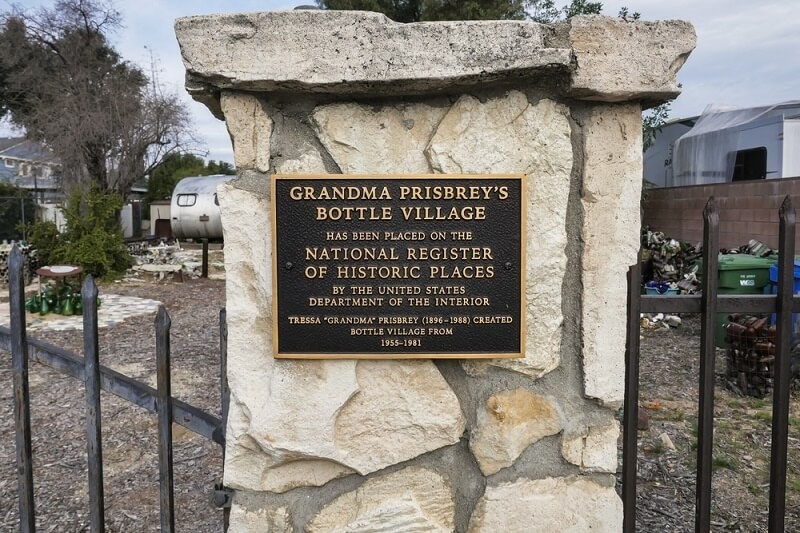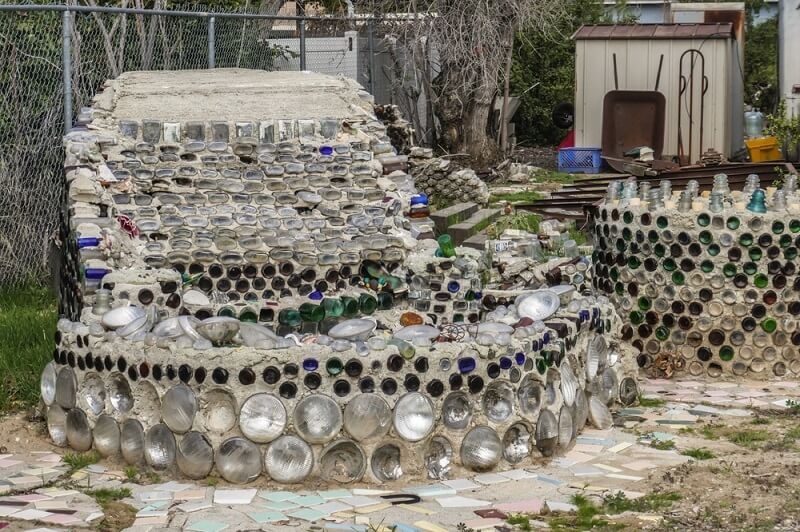
Drive through Simi Valley, and you’ll pass neat houses, quiet streets, and the kind of suburban calm you’d expect in Southern California. But tucked away on a modest plot of land sits something so unusual it stops you in your tracks: Grandma Prisbrey’s Bottle Village. What looks at first like a patchwork of glass and concrete is, in fact, one of America’s most remarkable examples of a folk art environment. Built by one determined woman using discarded bottles, tiles, dolls, and everyday junk, it has become both a cultural landmark and a testament to human imagination.
This isn’t just a quirky stop—it’s a site that challenges how we define art. Bottle Village art doesn’t rely on galleries or curators. It relies on memory, invention, and the hands of a grandmother who saw beauty in what others threw away.
To understand the place, you have to start with the woman. Tressa Prisbrey, later affectionately called Grandma Prisbrey, was born in 1896. She lived through a century of change—wars, the Great Depression, the consumer boom of postwar America. By the time she settled in Simi Valley in the 1950s, she had already raised a family and endured hardship.
But she wasn’t done building. What started as a simple idea—to create a space to house her collection of pencils—turned into a decades-long project. Piece by piece, she used bottles from the local dump to construct walls, walkways, shrines, and entire buildings. Tressa Prisbrey art was never polished or institutional; it was raw, colorful, and personal. Every bottle she set in mortar carried a memory or a practical use. Over time, her yard grew into what visitors would call Bottle Village—a community of structures that felt both whimsical and profound.
There’s a reason historians and preservationists call the site a folk art environment. Unlike traditional art that hangs in museums, Bottle Village immerses you in an entire landscape of expression. It’s not just about one sculpture or one mural; it’s a lived-in space transformed by an artist’s vision.
When you walk through Bottle Village, you see shrines made of doll heads, walls glittering with soda bottles, and towers that lean like playful parodies of monuments. Each corner feels alive with personality. The repetition of glass, light, and color creates a rhythm that turns junk into design.
Calling it a folk art environment also places it in the same conversation as other outsider art landmarks across America—hand-built worlds that blur the line between home and artwork. Prisbrey didn’t care about art-world validation. She cared about making something out of nothing, and that’s exactly what she achieved.
You may like: Hidden Parks Simi Valley: Discover Quiet Natural Escapes

The backbone of Bottle Village is glass. Thousands of bottles—beer, soda, medicine, milk—went into its walls and paths. Prisbrey’s technique was simple but brilliant: set bottles in mortar, necks facing out or sides stacked together, to form walls that shimmer in the sun.
These recycled bottle sculptures were more than decoration. They captured sunlight, cast colored shadows, and gave structure to an otherwise ordinary space. Green, brown, and clear bottles formed patterns like stained glass. Old television tubes and tiles became accents. Even broken glass was reimagined as mosaic detail.
The beauty of these recycled bottle sculptures is how they balance utility with creativity. A wall holds up a roof, but it also sparkles. A walkway guides your steps, but it also glitters with fragments of memory.
In its heyday, Bottle Village wasn’t just a private project—it became a draw for travelers and locals alike. Sitting right off the highway, the site quickly earned a reputation as a Simi Valley roadside attraction. People would stop, pay a small fee, and wander through Prisbrey’s shimmering fantasy world.
Unlike commercial roadside attractions built to entertain tourists, Bottle Village felt authentic. It wasn’t designed for profit; it was designed from the heart. That authenticity gave it a different kind of power. Visitors didn’t just gawk—they felt connected to the story behind the bottles.
Even today, though access is limited due to preservation issues, Bottle Village retains that aura of a Simi Valley roadside attraction that’s more than a curiosity.
More to Discover: Must Visit Simi Valley Landmarks with Free Entry for Tourists
As word spread, Bottle Village caught the attention of artists, journalists, and scholars. By the 1980s, it was being celebrated as one of the most important examples of outsider art in America. Eventually, it earned recognition as a California Historical Landmark and was added to the National Register of Historic Places in 1996.
But preservation hasn’t been easy. The 1994 Northridge earthquake devastated parts of the site, toppling walls and damaging structures.
What makes Tressa Prisbrey art timeless is not just its visual charm—it’s the story it tells. Her work is autobiography in three dimensions. Each structure reflects her resilience, humor, and creativity. She turned grief into shrines, memory into mosaics, and daily labor into an enduring masterpiece.
Bottle Village also challenges how we think about value. If one grandmother could take trash from a dump and turn it into a landmark, what does that say about the things we throw away every day? And what does it say about the stories hidden in ordinary lives?
While Bottle Village isn’t open daily like a museum, it still welcomes visitors during special events and tours organized by the preservation foundation. Walking through the site today, you’ll find crumbling but still magical bottle walls, doll shrines that blur the line between playful and eerie, and pathways that gleam under the California sun.
It’s not a slick tourist destination—it’s fragile, handmade, and intimate. But that’s part of its appeal. Whether you’re drawn to the story of Tressa Prisbrey art, the fascination of a folk art environment, or simply the visual spectacle of recycled bottle sculptures, a visit feels like stepping into someone’s dream.
Grandma Prisbrey’s creation is more than a local oddity. It’s part of a larger conversation about American creativity, resilience, and resourcefulness. Museums have exhibited photographs of the site, scholars have written about its significance, and artists continue to draw inspiration from it.
The legacy of Bottle Village art lies in its defiance of norms. It refuses to be dismissed as trash, and it refuses to fade quietly. As long as people care enough to preserve it, Bottle Village will continue to shine as one of the most imaginative landmarks in California.
Explore More: Historic Rancho Simi: A Timeless Rancho Simi History Tour
Grandma Prisbrey’s Bottle Village is proof that art can rise from the most unexpected places. On a small plot in Simi Valley, one woman built a world out of bottles and memory—a world that has become a landmark of creativity.
It’s a folk art environment that redefines what art means. It’s a Simi Valley roadside attraction that holds deeper stories than most tourist stops. It’s a shimmering collection of recycled bottle sculptures that turn waste into wonder. And above all, it’s the enduring testament of Tressa Prisbrey art, reminding us that imagination has no age limit and no boundaries.
This content was created by AI